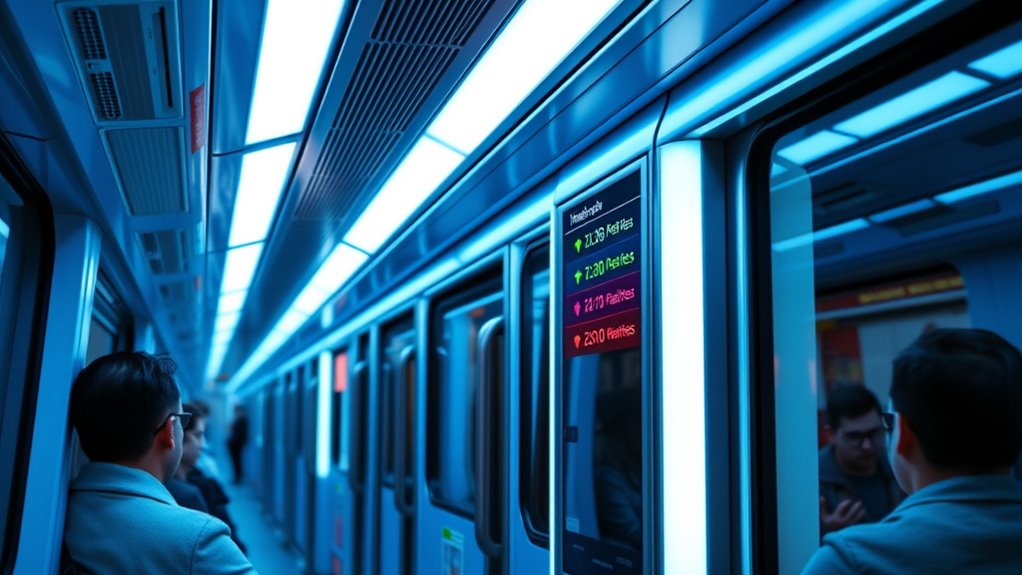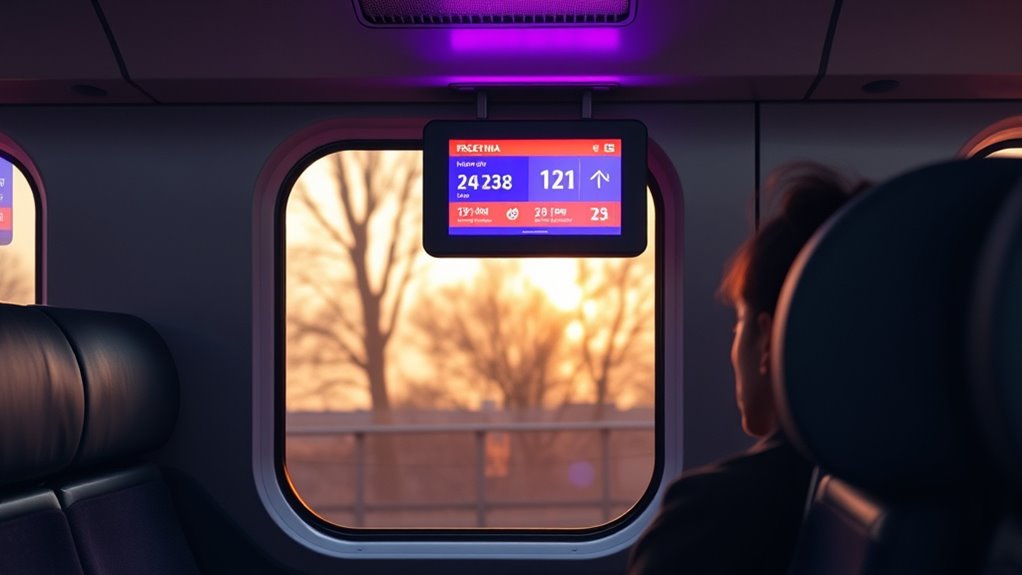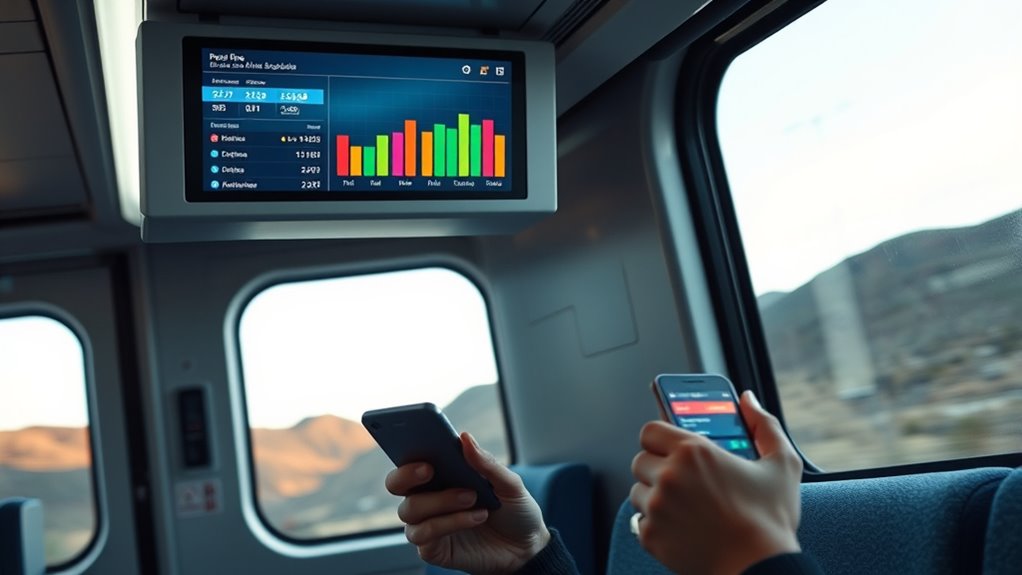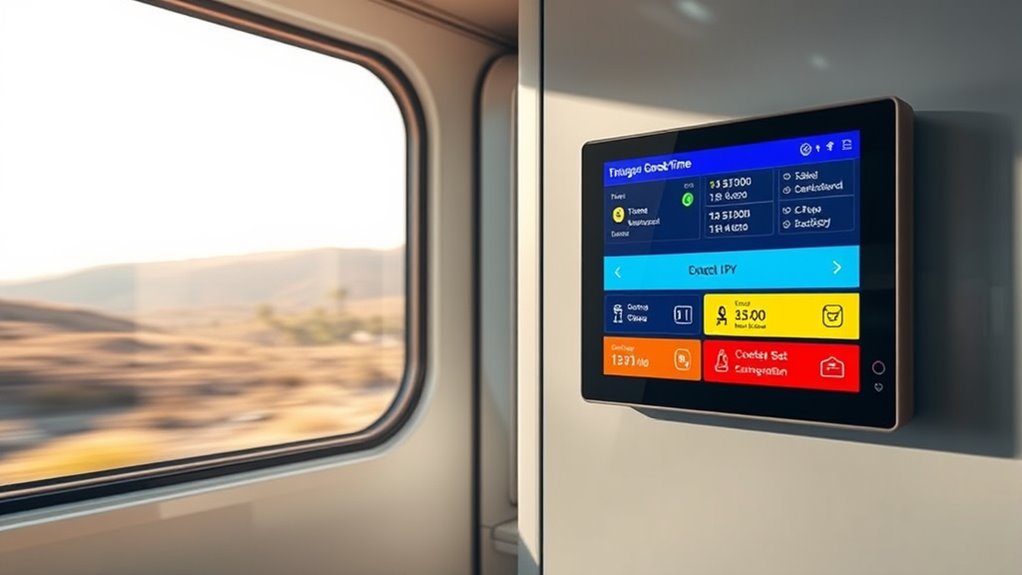When traveling by train, visual schedule alerts keep you informed about delays, platform changes, and safety instructions through digital screens and signage at stations, often complemented by mobile notifications. These signals help you recognize updates quickly, reducing stress and missed connections. Modern technology like GPS, real-time data, and personalized alerts enhance this system for smoother journeys. If you want tips on making the most of these signals and overcoming common challenges, there’s more to learn.
Key Takeaways
- Visual schedule alerts notify passengers of delays, platform changes, and safety information via station screens and onboard signage.
- Digital displays, icons, arrows, and bright colors effectively communicate real-time updates and emergency messages.
- Mobile apps and onboard screens provide instant, personalized alerts synced with ticket validation and GPS data.
- Familiarity with station signage and strategic positioning near screens enhance visibility and response times.
- Future advancements include AI-driven predictive alerts, smart device integration, and tailored notifications for improved travel experience.
Understanding Visual Schedule Alerts for Train Travel

When traveling by train, understanding visual schedule alerts is essential for staying informed about delays, departures, and platform changes. After booking your ticket, you’ll likely select your seat online or at the station. Once your booking is confirmed, pay attention to visual alerts displayed on station screens and onboard signs. These alerts provide real-time updates about your train’s status, including any delays or platform shifts. Recognizing these signals helps you move confidently and avoid missing your train. Keep an eye on screens near ticket counters or platforms, especially if you have a specific seat assigned. By staying alert to visual cues, you ensure a smoother journey, making sure you’re always aware of the latest schedule information without unnecessary stress. Additionally, understanding how visual alert systems work can help you interpret various signals more effectively, enhancing your overall travel experience.
Types of Visual Alerts You Can Expect on Your Journey

As you travel by train, you’ll see various visual alerts to keep you informed. These include station arrival notices, platform change updates, and emergency alert displays. Staying alert to these visuals helps guarantee a smooth and safe journey. Additionally, being aware of the financial investments made by travel companies can sometimes indicate the quality and reliability of the service.
Station Arrival Announcements
Station arrival announcements often come with visual alerts to keep you informed about upcoming stops. When your train approaches a station, digital screens and platform signage display clear, real-time information, so you know exactly when to prepare to disembark. Many passenger apps also sync with station systems, providing notifications with arrival times and station names directly to your device. These visual alerts help you stay alert without constantly listening for announcements, especially in noisy stations or if you’re hard of hearing. The combination of platform signage and digital notifications ensures you won’t miss your stop. As a traveler, paying attention to these visual cues makes your journey smoother and more efficient, giving you confidence and peace of mind throughout your trip.
Platform Change Notifications
Have you ever wondered what visual alerts signal a platform change during your train journey? When a platform change occurs, digital displays typically show a bright, flashing message indicating the new platform number. These alerts often appear right after ticket validation, making sure you’re informed immediately after your fare is checked. You might also see icons related to baggage handling, reminding you to collect or recheck your luggage if needed. Some stations display directional arrows guiding you toward the updated platform, helping you navigate efficiently. These visual cues are designed to be clear and prominent, so you don’t miss important updates. By paying attention to these alerts, you guarantee a smooth transition between platforms, avoiding missed trains or confusion during your trip. Additionally, good lighting ensures these signals remain visible and easy to read in various station environments.
Emergency Alert Displays
Emergency alert displays are critical visual signals that keep you informed during urgent situations. They quickly grab your attention with bright colors and bold text, guaranteeing you understand the message immediately. When safety is at stake, these displays can indicate evacuation procedures, track malfunctions, or security threats.
Using appropriate lighting and visibility ensures these alerts are easily noticeable, especially in low-light conditions.
Here are three key types of alerts you might see:
- Immediate evacuation instructions—helping you prioritize safety over seat comfort or ticket pricing.
- Track or station closures—prompting quick decisions that could affect your travel plans.
- Security alerts—alerting you to potential threats or hazards.
These visual alerts ensure you’re always aware of critical updates, so you can respond efficiently and keep your journey safe.
How Modern Technology Enhances Real-Time Updates

Modern technology has revolutionized how travelers stay informed about train schedules and delays. With real-time updates, you receive instant alerts on your smartphone or onboard screens, reducing uncertainty. When it comes to ticket validation, digital tickets or QR codes streamline the process, allowing quick validation without physical tickets. This also helps guarantee your seating arrangements are maintained accurately, preventing mix-ups. Train companies now use GPS tracking and live data feeds to update departure times and platform changes instantly. Push notifications notify you of any schedule adjustments, so you can plan accordingly. These advancements eliminate guesswork and enhance your overall travel experience, making it easier to stay informed, organized, and stress-free throughout your journey.
Benefits of Using Visual Schedule Alerts During Your Trip

Using visual schedule alerts can make your train journey smoother by helping you navigate stations and stops more easily. They also lessen your travel anxiety by providing clear, constant updates on your schedule. With these alerts, you’ll stay aware of your plans and avoid missing important connections or departures. Implementing real-time updates can further enhance your travel experience by ensuring you receive timely information about delays or changes.
Enhances Trip Navigation
When you rely on visual schedule alerts during your train journey, steering your trip becomes much simpler and more efficient. These alerts keep you informed about upcoming stops, platform changes, and important actions like ticket validation. With clear visuals, you can easily identify when to prepare for your train compartment or if you need to validate your ticket before boarding. Additionally, staying aware of timely updates helps you stay on schedule and avoid missing stops. Here’s how visual alerts enhance your navigation:
- Timely updates help you stay on schedule and avoid missing stops.
- Clear signals guide you to the correct train compartment, reducing confusion.
- Real-time notifications alert you for any platform changes or boarding instructions.
This streamlined communication ensures a smoother, more confident journey from start to finish.
Reduces Travel Anxiety
Visual schedule alerts markedly reduce your travel anxiety by providing constant, easy-to-understand updates about your journey. Knowing when your train arrives, which compartment to board, and where to validate your ticket keeps you confident and in control. With real-time alerts, you won’t worry about missing stops or confusion at the station. Instead, you can focus on your trip, knowing you’ll be informed of every step. When it’s time to validate your ticket, alerts guide you through the process seamlessly, reducing stress. Inside the train compartment, updates remind you of upcoming stops and any platform changes. This continuous flow of clear information helps ease your mind, making your train travel experience smoother and more relaxed. Awareness of train weights and safety considerations can also contribute to a more secure journey.
Improves Schedule Awareness
By keeping you informed with real-time updates, visual schedule alerts substantially enhance your awareness of the train’s timetable. They improve schedule accuracy, so you’re less likely to miss your train or wait unnecessarily. These alerts boost passenger engagement by providing clear, immediate information, making you feel more in control. Here’s how they benefit you: visual schedule alerts allow for quick understanding of upcoming changes, reducing uncertainty during your journey.
Devices and Platforms Supporting Schedule Notifications

Have you ever wondered how travelers stay informed about train schedules in real-time? Modern devices and platforms make it easy. Smartphones and tablets are primary tools, offering apps that send instant schedule notifications. Many stations also feature digital screens displaying real-time updates, helping you stay on top of train arrivals and departures. Some platforms integrate schedule alerts with ticket validation systems, so once you validate your ticket, you receive personalized alerts about your train. Additionally, baggage handling systems now connect with schedule notifications, alerting you if there’s a delay affecting your baggage claim or transfer. These platforms streamline your journey, providing timely alerts to help you plan better and avoid missing your train, all while simplifying processes like ticket validation and baggage handling. Understanding the refrigeration cycle can also be useful in maintaining your travel appliances for optimal performance.
Tips for Maximizing the Effectiveness of Visual Alerts

To make the most of real-time schedule updates, it’s important to optimize how you interpret and respond to visual alerts. Pay close attention to station signage, as they often display critical information clearly. To enhance your experience, consider these tips:
- Familiarize yourself with station signage so you can quickly identify updates without confusion.
- Stay alert to passenger communication, such as staff instructions or digital displays, which often complement visual alerts.
- Position yourself strategically near signs or screens to ensure you don’t miss important updates during busy times.
Common Challenges and How to Overcome Them

Managing visual alerts on trains can be challenging, especially when signals are unclear or when you’re in a crowded environment. During busy travel times, it’s easy to miss important schedule updates or platform changes, which can disrupt your plans. Ticket booking processes might not always sync with real-time alerts, causing confusion about departure times. Luggage handling adds another layer of difficulty, as bulky bags can block your view or make it harder to focus on visual signals. To overcome these challenges, stay alert and position yourself where signals are most visible. Use mobile notifications as a backup, and double-check your ticket details before arriving. Keeping your luggage organized and close can help you remain attentive to schedule updates, ensuring smoother train journeys.
Future Trends in Train Schedule Notification Systems

Emerging technologies are transforming how train schedule notifications are delivered, making them more accurate and personalized. Over time, historical developments have refined notification systems, integrating real-time data for better reliability. Passenger feedback plays a vital role, guiding system improvements and ensuring user needs are met. Future trends include:
- AI-driven predictive alerts that anticipate delays based on weather or traffic patterns.
- Personalized notifications tailored to your travel preferences and device usage.
- Enhanced integrations with smart devices, providing seamless, visual schedule updates directly on your smartwatch or mobile app.
- Incorporating emotional support features to help travelers manage stress or anxiety during delays, making the experience more comfortable.
These advancements aim to make train travel smoother and more convenient, building on past innovations and continuously adapting to passenger input. You’ll soon experience more intuitive, proactive alerts that keep you informed every step of your journey.
Frequently Asked Questions
Are Visual Alerts Available on All Train Routes Worldwide?
You might wonder if visual alert systems are available on all train routes worldwide. While many modern trains feature train schedule updates with visual alert systems, not every route has this technology. It depends on the country, operator, and train type. Some regions prioritize these systems for safety and convenience, but others may still rely on announcements or digital displays. Always check your specific route for available visual alerts before traveling.
How Do Visual Alerts Differ From Audio Announcements?
Visual alerts differ from audio announcements by providing a clear, visual cue difference that can be readily perceived, even in noisy environments. You can often customize these alerts to suit your preferences, such as adjusting brightness or display style. Unlike audio alerts, which depend on hearing, visual cues ensure you receive important schedule information regardless of ambient noise, making your travel experience more accessible and tailored to your needs.
Can Visually Impaired Passengers Benefit From These Alerts?
You can benefit from visual schedule alerts if they incorporate tactile indicators or Braille displays, making information accessible. These features help you interpret schedule updates and station changes through touch, providing independence and safety. When trains include such accessible alerts, you can stay informed about your travel plans without relying on visual cues alone. This inclusivity guarantees a smoother, more confident journey for visually impaired passengers.
Are There Privacy Concerns With Real-Time Schedule Data Sharing?
Imagine your schedule is a secret garden, protected by a gate. When real-time sharing of schedule data happens, it’s like opening that gate for everyone, risking your privacy. Data privacy concerns arise because sharing schedule info in real time might expose personal details to unintended viewers. You need safeguards to guarantee your information stays secure, even as you benefit from the convenience of real-time sharing, preserving your privacy while staying informed.
How Often Are Schedule Notifications Updated During Delays?
During delays, schedule notifications typically update frequently to keep you informed. The update frequency depends on the system, but many services send delay notifications every few minutes, ensuring you’re aware of changes as they happen. This constant update process helps you plan better, reducing uncertainty. You’ll see timely delay notifications, giving you the latest schedule info, so you can adjust your travel plans smoothly and stay in the loop.
Conclusion
As you travel by train, let vibrant visual alerts be your guiding lights, illuminating your journey like bright signs in a bustling station. These alerts keep you grounded amid the moving scenery, ensuring you never miss a stop or connection. Embrace the seamless flow of real-time updates, and trust in the technology that transforms your travel experience into a smooth, confident ride—where every visual cue leads you safely to your destination.










